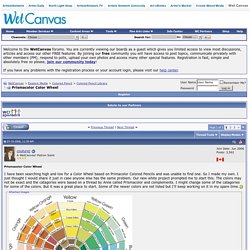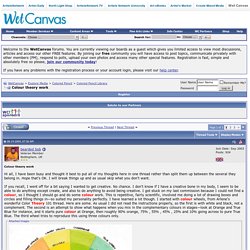

Learn to draw.com, learn how to draw online for FREE! Colored Pencil Demo - Feathers. Lets start with the supplies you’ll need.

You don’t have to have it all to get started, but you will find that each item will come in handy as you become more familiar with colored pencils. Colored Pencils – There are several brands of colored pencils, some easier to find than others, some better than others. My personal favorite is Prisma Color for several reasons. They are very creamy, have a wide range of colors and most of all, I can get them in my local art supply store. Never by the student grade pencil in any brand. Colorless Blender – This is a colored pencil without any pigment. Paper – The type of paper you use can make a big difference in the end result. Transfer paper – The watercolor paper won’t hold up to a lot of erasing. Kneaded Eraser – Kneaded erasers are a great invention. Electric Eraser – This is not something you have to have, but there are times where it’s very useful. How to Paint Photorealism: A Step-by-Step Guide on How to Paint Your Own Photorealistic Paintings. If you want to learn how to paint photorealism, these next few pages will walk you step by step through the photorealist painting techniques that I use to create my photorealistic paintings, such as the ones on the right.

This step-by-step guide may be an equally interesting read for non-artists who have a deep appreciation for photorealist art and want to understand how photorealist paintings are created, from start to finish. You can see more of my photorealist work on my art website. There are many mediums an artist can use to paint (or draw) photorealistically. The most common are oils, acrylics (paintbrushed or airbrushed), watercolor, graphite, colored pencil, and pastel. The majority of my photorealist work is done in acrylics using a paintbrush (as opposed to an airbrush), although I have used watercolor and colored pencil as well. Who am I? I am a self-taught Photorealist painter, focusing primarily on photorealistic still lifes. Materials Transferring the photo Paint! Materials. Prismacolor Color Wheel. Here is some of the information that I could find regarding color theory that may be helpful especially for beginners like myself.

Definitions: Primary Colors: Red, yellow and blue – cannot be mixed from any other colors.Secondary Colors: Two primary colors mixed together resulting in orange, green and violet.Tertiary (Intermediate) Colors: One primary and one secondary mixed together.Aggressive (Warm) Colors: Reds, oranges and yellows.Receding (Cool) Colors: Greens, blues and violets.Hue: Another name for color.Tint: Color + WhiteTone: Color + GrayShade: Color + BlackKey Color: Dominant color in a color scheme or mixture.Neutral Grey: Combination of black and white.Intensity or Chroma: The brightness or dullness of a color.
Quoted from Pocket Color Wheel Refer to the Color Wheel for color combination ideas and to see which colors complement each other. With colored pencils, you are layering semitransparent pigment, so colors change when placed one over another. Colour theory work. What did I learn?

That this is actually a lot more complicated than Arlene sets out, which is perfectly understandable as she set out to do a beginners course. If you want to look at color theory 501, then have a look at www.handprint.com - a guy called Bruce McEvoy, who I have not heard of, but may be some famous artist. He has pages of post-grad level stuff that I could not follow but which does raise lots of interesting points. What else? - that if you place a colour opposite another on a colour wheel, that does not necessarily make them complementary. So if you stretch the spectrum around a circle, the actual placement of colours should look more like this, making colours opposite that you would not expect.
That there is no such thing as a primary colour, you can pick and choose which ones you like. That it is very easy to make mud with three pencils, but quite hard with two. That I should have tried this on good paper, not the heavyweight cartridge I used. Handprint. COLORED PENCIL Magazine. Annkullberg.com - for all things Colored Pencil!